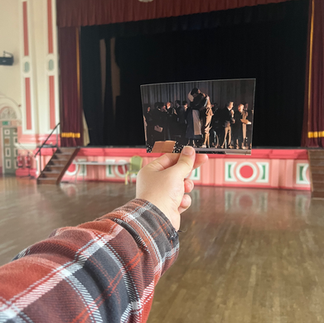Exploring the Yorkshire locations that inspired The Choral
- joshanthonyharris
- 7 days ago
- 6 min read

Don your best suits and put on the war time classics, as you join me exploring the locations that brought this Alan Bennett movie to life. When cinema captures the soul of a location, it has the power to turn quiet and forgotten corners into unforgettable destinations, and The Choral is already doing just that. This moving new drama interweaves music, community, and personal transformation, all set against the atmospheric beauty of rural North England. With sweeping landscapes, intimate village scenes, and a story rooted in belonging, The Choral has quickly become a film that invites the audience to not only watch, but explore.
The Choral follows the journey of a troubled young musician who returns to his hometown after years away, only to find both comfort and conflict in the choir that once shaped his childhood. As he attempts to rebuild his life, reconnect with old friends, and face painful memories, he discovers the healing power of harmony — not just in music, but within himself and the community that raised him. This emotional narrative blends humour, heartbreak, and hope, offering an intimate look at resilience, reconciliation, and the power of shared voices.

One of the standout elements of The Choral is its awe-inspiring backdrop. Production took place across North & West Yorkshire, with filmmakers choosing authentic local villages, rolling countryside, and historic town centres to bring the story to life. Rather than building sets, the production crew chose to lean into real community spaces, from grand town halls and market squares to an impressive hotel and winding rural lanes.
The result is a film deeply rooted in place, with Yorkshire’s charm playing a role as vital as any character. The region’s natural beauty and architectural heritage lend warmth, texture, and a sense of grounded realism that enhances every scene.
The Crown Hotel, Harrogate

One of the most intriguing filming locations for The Choral was the historic Crown Hotel in the centre of Harrogate. This Grade II listed building dating back to the 1740's with various Italianate additions in the 19th century was the perfect choice for grand dining room scenes and an intimate office space. With it's grand facade, period character and architectural elegance, the production team made perfect use of this space. Their 3 day trip for filming in June 2024, was the first time the team had left West Yorkshire for filming, and this choice was perfect, with the grandeur adding a perfect atmosphere for some impressive scenes.
The two spots used in the hotel were the Churchill Suite Restaurant and the Montpellier Suite. The first is used as the breakfast dining hall for the hotel and for events, which means you can easily visit this space for yourself. With it's oak panelled walls, stained glass windows, and ornate ceiling decorations, this elegant space made for the perfect room for dining scenes with that classic First World War look. The Montpellier Suite was used briefly for an office scene, and even though it wasn't used as much this space was painted just for production to provide the look and feel they required.
Keighley Railway Station

The picturesque and historically rich Keighley railway station in West Yorkshire played a key role as a filming location for this movie, with soldiers coming back to their loved ones. This station serves as the terminus for the Keighley & Worth Valley Railway (KWVR), meaning they have carefully kept the period features intact. With a vintage platform, classic ironwork, and old style architecture, production teams can use this preserved location for period set films & TV shows, Many of these are WWI set productions with Peaky Blinders Series 1, Yanks, Testament of Youth and now The Choral.

Filming crews were able to dress the platform with period appropriate signs, platform dressings and extras in early 20th century costume. The platform being separate from the rest allows for the production crew to film the scenes on a 1900's setting whilst the modern everyday world continues on the rest. So whether you visit for The Choral or the several other productions filmed here, you will feel like you're instantly stepping back in time as you walk onto the platform or get on the old fashioned steam train.
Saltaire

The majority of The Choral was filmed in the heart of Saltaire, a UNESCO-listed model village in West Yorkshire, and it’s easy to see why filmmakers were drawn to it. With its perfectly preserved Victorian streets, warm sandstone terraces, and striking architecture from the mill to the town hall, Saltaire offers a ready-made period backdrop that feels both authentic and lived-in.
Rather than relying heavily on studio sets, the production chose to immerse itself in real spaces. Much of the film unfolds out in the open: cobbled lanes, tree-lined canal path, and characterful courtyards form the visual language of the story. By shooting extensively across Saltaire’s residential streets and historic conservation area, the filmmakers achieved a grounded, intimate look that mirrors the film’s themes of community and belonging, that a set couldn't replicate.

During filming, parts of the village saw temporary dressing, with period-appropriate signage, classic bicycles, and subtle touches to transport the setting back in time. Locals spotted cast and crew weaving between terraced houses, setting up along narrow streets and around the edges of the imposing Salts Mill, using the village’s natural rhythm rather than reshaping it.
What makes using Saltaire so powerful on screen is not the grandeur, but the understated quiet beauty. From the warm stone, the symmetry of the streets and back alleys, and the sense of history embedded in every row of houses. It gives The Choral a real sense of place. For film-tourism fans, wandering Saltaire after watching the movie feels like stepping directly into its world. And the best part? The village’s compact size makes it easy to explore on foot, letting visitors trace the film’s footsteps through charming streets and riverside paths that look almost exactly as they do on screen.
Victoria Hall, Saltaire

One of the most recognisable filming locations in The Choral is Victoria Hall in Saltaire, a grand civic building that perfectly matches the film’s period atmosphere. Built in the 19th century and rich with architectural character, from its sweeping staircases, arched windows, and ornate interiors, the hall served as an ideal backdrop for key community scenes in the movie.
Production teams transformed the main hall space to reflect the film’s early-20th-century setting, using authentic props, vintage lighting, and local extras to create a theatre full of character and energy. The hall’s elegant main room and warm wooden features meant very little needed altering, with it already providing the classic 1910's and WWI backdrop. Crew were seen setting up in the main hall with lighting rigs, sound equipment, and period-costume wardrobe rails along the exterior. Locals reported temporary closures and signage around the site as filmmakers moved equipment in and out while carefully preserving the building’s historic interior.
By choosing Victoria Hall, the filmmakers grounded The Choral in real Yorkshire heritage. On-screen, the venue becomes more than just a backdrop, it represents the beating heart of the film’s fictional community, where music brings people together and moments of emotion and celebration unfold.

The Choral doesn’t just tell a story, it envelops the audience into one. Through its powerful themes of community, music, and belonging, the film captures the heart of Yorkshire, using real locations to give every scene a sense of truth and place. From the atmospheric streets of Saltaire to the historic Crown Hotel in Harrogate and the charming platforms at Keighley station, the production embraced the region’s character rather than recreating it in studios.
For fans inspired by the film’s scenery, the best news is that these locations are wonderfully accessible. Visitors can stroll the cobbled lanes of Saltaire, admire the Victorian grandeur of Victoria Hall, stand where key scenes unfolded at the Crown Hotel, and even catch a heritage train from Keighley. Many of these sites are open to the public year-round, making it easy to turn your love for the film into a real-world adventure.
Whether you’re planning a day trip or mapping out a full Yorkshire film-tour getaway, exploring these filming spots offers a chance to relive the story, discover local history, and experience the landscapes that shaped The Choral on screen. Pack your curiosity, bring your camera, and get ready to walk straight into the movie magic, and the best part no ticket is required.

















































Comments